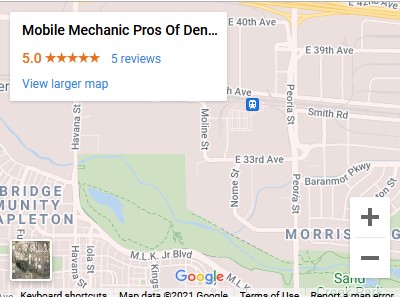Car Oil Change in Denver
Car Oil Change Arround Denver

When you go for an oil change in Denver, the technician will:
- Check your vehicle's motor oil levels and quality
- Change the engine air filter
- Clean out the pollen from inside of your car if needed
- Examine all other important parts to ensure everything is running smoothly!
There are a lot of mobile mechanics around these days, and they provide an excellent service. The best part is that you don't even need to have your car towed into a shop anymore just because it's broken! They come right to you.
Why oil breaks down?
The answer to this fascinating question is surprisingly something rather mundane. Oil breaks down because it simply doesn't like staying inside your engine.
Oil can't stand pressure as well as water so as the pistons create a vacuum with every cycle, oil gets sucked upwards and its molecules are ground up against metal surfaces causing sludge and eventually breaking down into unusable particles of black sludgey goo.
Free Instant Quote
How often should I have my oil changed?
Different cars have different recommended timelines for their engine oils (some recommend 7500 miles). The visit is usually predicted by checking how frequently do you drive, what type of driving are you doing (constant stop-and-go driving may not allow time for oil get between parts), and how old is your vehicle. Unleaded fuels also make this worse because they have been shown to decrease the quality of oil during combustion.
***
What parts are used in pumping oil around the engine?
- Oil Pan
- Oil Pump
- Oil filter
Oil Pan: One of the most important parts to maintain in an engine is the oil pan, sometimes referred to as a sump, which collects and stores engine oil. The oil pump forces the cold motor oil through the mechanical compression pump (located on the outside of the engine block), where it enters (via small holes) one end of the sump. The other end of the sump is open to an area that is at or near atmospheric pressure, allowing gravity to cause all or part of the oil to return to the pan.
The Oil Pump: The oil pump has come into existence to reduce human effort (and chance for operator error). It reduces wear on engine components by being one tough machine made up mostly of gears and has a variety of valves and pistons that do the work.
Oil Filter: The oil filter is an important part of your engine lubrication system, as it keeps tiny metal particles from being dispersed throughout the engine as well as trapping contaminant molecules before they can damage delicate engine components.
How to check your oil car yourself?
To check oil level in a running engine, turn engine off and wait until all the moving parts have stopped. You can also ask an expert in the automotive shop in the city you live to do it for you.
Step-by-step:
1) Park your car on a level surface. Park near your home or office so that if there is trouble with your car, someone can help by giving you a ride.
2) Turn off your vehicle but don't open any of its doors yet since this will create air turbulence when opening/closing them which could make checking for leaks difficult later on;

3) Stick an engine-temperature stick (a thermometer with a long metal probe) in the front of hose connected to your radiator, an area near the battery or choose another part of the engine which is close to any of these two. You might want to wait a few minutes for temperature reading to stabilize
4) Open up your car's hood and prop it open by putting a brick on its lid
5) Put on gloves and safety glasses to keep your hands and face free from oil and other engine fluids
6) Walk up to your car's front end of the vehicle;
7) Look for a cover that protects the engine of your car. It may be located under or near where you would put windshield wiper fluid or in the engine compartment
8) Look for a black-colored oil dipstick with a handle. This is your vehicle's oil dipstick, which should be either on the driver's side or at the center of the front part of an engine compartment.
9) Pull out your car's dipstick and wipe it clean using paper towels or an old rag.
10) Put your car's dipstick back in, push it all the way in until you've felt a 'clicking' sound. Your oil level should be at the mark "full" and your engine may be in trouble if there is no oil inside.
You can avoid the hassle of an oil change with our mobile service. Get your fluids replaced while you wait, and call us if there's anything else that needs attention!



